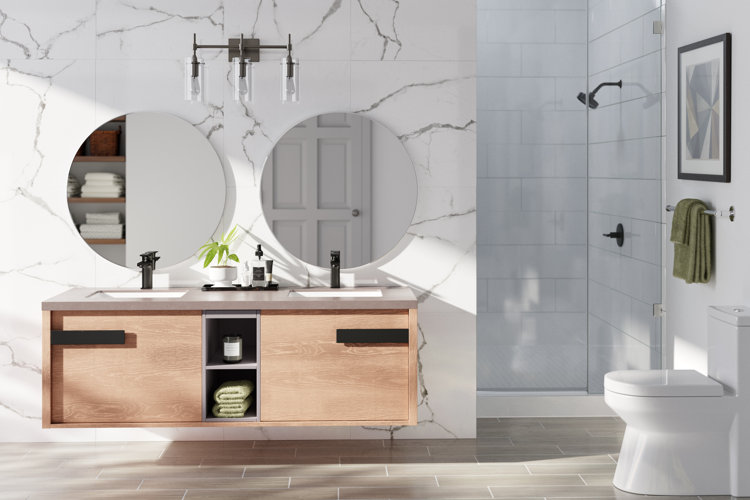Travertine vs. Marble: Which Material Is Better?
Discover the right natural stone for your space.
With organic appeal and timeless style, natural stone adds a beautiful element to any room. The durable material is strong enough to withstand everyday wear, while the soothing neutral tones bring a bit of the outdoors inside. Natural stone is an excellent option for floors, countertops, backsplashes, and more. There are a wide variety of natural stones to choose from, so we've created this guide to help you compare travertine vs. marble. Read on to learn about the differences between these two types of stone, where you should use them, and which one works best for you.
Travertine vs. Marble
Difference in Cost
Appearance
Durability & Maintenance
Where Should You Use Each?
Travertine vs. Marble
Both travertine and marble add an earthy quality to your home. They bring an elegant and subtle style to kitchen counters, bathroom backsplashes, and more. Though both types of stone feature swirling layers of natural color, each stone has its own set of distinct characteristics.
Travertine is a type of limestone that is made by compressing sediment and calcium carbonate under high heat and pressure. This type of sedimentary stone is often formed around hot springs or limestone caves and has a porous texture left from hot water and gasses being expelled through small channels inside the stone. Travertine also has an earthy color filled with streaks of naturally varying colors.
Marble is another type of limestone, but one that has undergone much higher heat and more intense pressure, to the point that it has recrystallized into a much harder, denser stone. Marble is known for its beautiful variations, natural veining patterns, and variety of colors.
Though prices can depend on the thickness, installation, or finish of the stone, travertine is typically half the price of marble. This makes it an excellent alternative if marble doesn't fit within your budget. Plus, travertine can be polished to a glossy finish that is just as beautiful as marble – just at a much more approachable price point.
Travertine and marble have distinct appearances that set them apart from each other.
Travertine typically has a warm earth-toned color, such as ivory, beige, brown, or rust. It also has tiny holes or channels left from when the hot water and gasses were pressed through the stone during its formation. This organic finish and unique variation makes travertine a great option when choosing a natural stone.
Marble can come in a wide range of natural hues, ranging from milky gray to dark brown. The color and amount of veining can vary as well. Some pieces of marble can appear as one color with minimal veining. White-and-gray swirled marble is a popular choice for creating an upscale and elegant space.
Generally, both travertine and marble are durable enough to withstand everyday use. However, there are a few considerations to keep in mind when you’re choosing between travertine and marble.
Travertine is more prone to scratching or chipping than marble, and it has small holes in its composition. It's typically sealed to keep excess moisture from getting in these holes or crevices. Travertine needs to be sealed every year or two to protect the surface from damage. If left unsealed, travertine can gain an aged appearance over time. Some people prefer this patina and find that this weathered appearance matches their aesthetic. If you plan on leaving the travertine unsealed, the stone is more likely to chip, crack, or stain.
Since marble is formed under more intense heat and pressure (that causes it to recrystallize), it is much harder and denser than travertine. Despite its increased durability, marble also needs to be sealed to protect the stone and prevent excess wear. To keep your marble in the best condition, we recommend sealing countertops or floors at least once a year.
Where you plan on placing each type of natural stone can also help you decide which is better suited for your lifestyle.
Travertine
Travertine can be placed in any location where you'd typically install a ceramic tile. It adds natural texture and a rich earthy color to floors, countertops, and backsplashes. However, if you want to install travertine tile in a high-traffic space, be prepared to reseal these areas more often than in low-traffic areas.
Additionally, travertine is a porous stone and needs to have a watertight sealant that keeps water from getting in the small holes and crevices.
Marble
Because of its beautiful color, high durability, and unique pattern, marble is a popular choice for countertops, kitchen islands, showers, backsplashes, entryway floors, and fireplace surrounds. For high-traffic spaces or areas that come in frequent contact with water (like kitchens or bathrooms), make sure to seal your marble regularly to prevent damage from excess water or acidic foods.
Tip!
Want to learn more about travertine? Check out our guide Travertine vs. Limestone: Which Is Best? to compare travertine and limestone.

